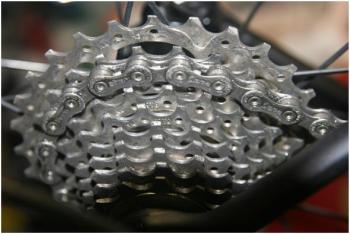
By Stan Purdum
Assuming you’re talking about a bicycle with the gear mechanisms out in plain sight, which is the most common way bicycles are geared, the hardest (highest) gear is when the chain is on the biggest toothed ring by the pedals (called the “front” in shifting jargon, even though the pedals are in the middle of the bike) and the smallest toothed ring on the rear wheel.
The easiest (lowest) gear is when the chain is on the smallest ring in the front and the largest cog in the rear.
The rest of the gears range between those two extremes.

The ring(s) in the front are individually called chain rings. Geared bicycles come with one, two or three rings (notated as 1x, 2x and 3x) and together the set of chain rings is called a crankset.

The rings in the back are individually called cogs. Geared bicycles come with anywhere from five to 12 cogs, and the stack of cogs is called either a cassette or a freewheel depending on type, but most modern bikes have cassettes. From a user point of view, cassettes and freewheels look similar and function the same.
The devices that move the chain from one ring to the other are called derailleurs, which are activated by shift levers, usually mounted on the handlebars. On most bikes, the shift levers are connected to the derailleurs by cables that manually move them. Some modern, high-end shift systems operate the derailleurs electronically, either by wires or wirelessly.
A derailleur will be affixed to your bicycle frame beside the rear wheel to move the chain from one cog to another. If your bicycle has a 2x or 3x crankset, you’ll have another derailleur mounted above the crankset. A 1x crankset doesn’t need a front derailleur since the chain never leaves the single chain ring.
All these components together — crankset, cassette (or freewheel), chain, derailleurs, shift levers and cables (or electronics) — are the bicycle’s drivetrain. It’s possible with current derailleur drivetrains to have 30 or more gears, though it’s more common to have gears numbering in the 20s or the teens.
Some bikes are geared without using exposed toothed rings and derailleurs. These internally geared hub systems have the shifting mechanisms inside the hub of the rear wheel and are operated by a cable activated by a shift lever. With their moving parts in the hub, they are protected from the elements and thus need less maintenance than derailleur systems, but they cannot provide as many gears as can conventional drivetrains.
you didn’t answer the actual question. ” the fastest gear combination”… assuming you want top speed while cycling normally…what should be the combination of front and rear rings ..
The fastest is the hardest gear.
I have an e bike just started using it When going up hill & cant quite make it should I switch to a smaller diameter cog in the rear to help me get up the hill